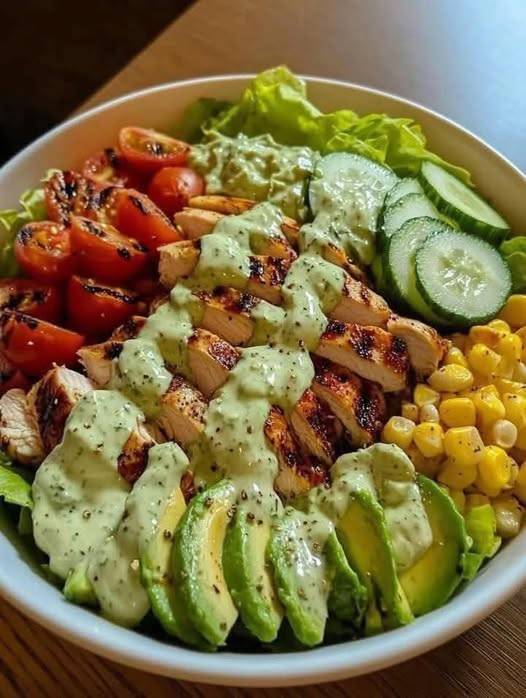Cyndi Bernstiel has worked in the legal field for over 25 years. She has spent most of those years working as a litigator for large insurance companies, helping to investigate suspicious claims and subvert insurance fraud. She works at McClellan Bernstiel LLP in Blue Bell, PA, and is licensed to practice law in PA, MD, NY, and OH. One of her primary areas of expertise is arson investigations. She has undergone extensive training and worked on numerous cases, successfully saving insurance companies from paying out on many cases where insurers were involved in causing the fire. She is often asked to speak at conferences, training events, and other occasions and loves getting to share her knowledge. http://cyndibernstiel.com/
Don't wanna be here? Send us removal request.
Text

Ingredients: 1 grilled chicken breast, sliced 2 cups romaine or mixed greens ½ avocado, diced ½ cup cherry tomatoes, chopped ½ cup cucumber, sliced ½ cup grilled corn 1 tbsp olive oil ½ tsp black pepper ½ tsp garlic powder
408 notes
·
View notes
Text
Eat Anytime Sunflower Seeds – Healthy, Crunchy & Nutrient-Rich Snack

Enjoy the natural goodness of Eat Anytime Sunflower Seeds, packed with protein, fiber, and essential vitamins like Vitamin E and B-complex. These lightly roasted seeds make for a deliciously crunchy snack that supports heart health, boosts immunity, and promotes glowing skin.
3 notes
·
View notes
Text

Potatoes (149g), butter (5g), cod (188g), shrimps (91g), oil (7g), flour (8g), cucumbers (116g), tomatoes (145g), deep roasted sesame dressing (15g), green onion, smoked salt, chilli & garlic salt, pepper mix, dill, garlic, lemon juice, cola zero - 546 kcal
17 notes
·
View notes
Text
Zesty Lemon Butter Fish Fillet

Ingredients:
For the Fish:
* 4 white fish fillets (cod, tilapia, or haddock)
* 1 teaspoon paprika
* 1 teaspoon garlic powder
* 1 teaspoon onion powder
* 2 tablespoons olive oil
* Salt and pepper, to taste
For the Lemon Butter Sauce:
* 4 tablespoons butter
* 2 tablespoons olive oil
* Juice and zest of 2 lemons
2K notes
·
View notes
Text
The Role of Continuous Learning in Career Advancement | Cyndi Bernstiel

In a fast-paced world shaped by constant innovation and change, one truth stands firm: those who continue to learn, and grow. Continuous learning—the process of acquiring new skills, expanding knowledge, and adapting to new challenges—is no longer a luxury; it’s a necessity for career advancement.
Whether you’re an entry-level employee or a seasoned leader, embracing a learning mindset can unlock new opportunities, increase your value in the workplace, and future-proof your career.
1. Staying Relevant in a Changing World
Industries evolve rapidly due to advances in technology, market shifts, and global trends. What was in demand five years ago may already be outdated today. Continuous learning helps you stay current and relevant in your field. From understanding the latest tools to mastering emerging methodologies, lifelong learning ensures you don’t fall behind—and may even place you ahead of the curve.
Professionals who commit to learning demonstrate adaptability, a key trait that employers highly value in uncertain and evolving work environments.
2. Boosting Confidence and Competence
Learning new skills does more than pad your resume—it boosts your confidence. When you acquire knowledge, you become more capable of tackling challenges, taking on bigger responsibilities, and contributing meaningfully to your team or organization. This increased competence is often the foundation for promotions, leadership roles, and more strategic projects.
Confidence, backed by competence, also allows you to advocate for yourself more effectively when seeking raises, new roles, or career shifts.
3. Opening Doors to New Opportunities
Continuous learners tend to be more open to change—and that openness leads to new opportunities. Whether it’s moving into a new department, changing industries, or even starting your own business, lifelong learning equips you with the tools to explore these options.
Employers often look for self-starters who are eager to grow and evolve. Being proactive about learning can set you apart in hiring processes and internal evaluations alike.
4. Learning Beyond the Classroom
Continuous learning doesn’t always mean going back to school. It can take many forms—reading industry blogs, attending webinars, enrolling in online courses, listening to podcasts, or seeking mentorship. Even on-the-job experiences like cross-functional projects or feedback sessions can be powerful learning moments.
What matters most is maintaining curiosity and making learning a regular habit, not just something you turn to in moments of crisis or change.
5. Cultivating a Growth Mindset
At the heart of continuous learning is the belief that growth is always possible. This growth mindset fuels resilience, creativity, and long-term success. When you view challenges as opportunities to learn, rather than threats to your competence, you become more innovative and solutions-focused—qualities that define strong leaders.
In today’s world, learning is not a phase—it’s a career-long journey. By embracing continuous learning, you not only enhance your current performance but also prepare for the opportunities of tomorrow. Whether you’re aiming to climb the ladder, pivot to a new path, or simply become the best version of yourself, learning will always be your greatest ally.
0 notes
Text
How to Create a Sustainable Meal Plan for the Week | Cyndi Bernstiel

In today’s fast-paced world, meal planning has become an essential strategy for many people looking to eat healthier, save time, and reduce food waste. However, creating a meal plan that is both sustainable for the planet and practical for your lifestyle requires a thoughtful approach. Sustainability in meal planning goes beyond simply eating healthy; it also involves making choices that minimize environmental impact, conserve resources, and reduce food waste. Here’s how you can create a sustainable meal plan for the week that benefits both you and the planet.
1. Start with Seasonal and Local Ingredients
One of the easiest ways to make your meal plan more sustainable is by focusing on seasonal and local produce. Fruits and vegetables that are in season require less energy to grow, transport, and store, reducing their carbon footprint. Visiting local farmers’ markets or joining a community-supported agriculture (CSA) program is a great way to access fresh, seasonal produce while supporting local farmers.
When planning meals, take advantage of what’s abundant during the time of year. For instance, in summer, tomatoes, cucumbers, and berries are often in season, while in fall, root vegetables like carrots, sweet potatoes, and squash are abundant. Eating seasonally not only supports sustainability but also ensures you’re getting produce at its peak flavor and nutritional value.
2. Incorporate Plant-Based Meals
Incorporating more plant-based meals into your weekly meal plan is a key step toward sustainability. Animal agriculture is a major contributor to greenhouse gas emissions, water usage, and land degradation. By reducing your reliance on meat and dairy products, you can significantly reduce your environmental impact.
You don’t need to go fully plant-based, but you can start by dedicating a few meals each week to plant-based dishes. Consider meals like stir-fries, grain bowls, salads, or pasta with vegetable-based sauces. Incorporating beans, lentils, tofu, and other plant proteins into your meals can provide the same satiety as meat-based dishes while being more sustainable.
3. Use Whole Foods and Minimize Processed Items
Whole foods, such as grains, beans, nuts, seeds, and fresh vegetables, are generally more sustainable than processed foods. Processed foods require more packaging, energy for production, and transportation. By choosing whole foods, you can reduce the environmental cost of your meals and improve your overall health.
When planning your meals, aim to include whole grains like quinoa, brown rice, and oats, as well as legumes like lentils and chickpeas. These foods are nutrient-dense, filling, and versatile, making them great choices for meal planning.
4. Reduce Food Waste by Using Leftovers Creatively
Food waste is a significant issue in many households, but with a little creativity, you can minimize waste while still enjoying delicious meals. Plan your meals in such a way that you can reuse leftovers. For example, if you make a large batch of vegetable soup, you can repurpose it into a stew later in the week. Similarly, roasted vegetables can be used in salads or grain bowls, and extra rice can be turned into stir-fry or added to soups.
Another tip is to repurpose food scraps. Vegetable peels, stems, and other leftovers can often be turned into broths or composted, reducing waste even further.
5. Plan for Balance and Variety
A sustainable meal plan isn’t just about being eco-friendly; it also needs to be nutritionally balanced and enjoyable. Plan meals that offer a variety of nutrients, including protein, fiber, healthy fats, and vitamins. This helps ensure that you’re getting the necessary nutrients for a healthy diet while reducing the temptation to purchase takeout or unhealthy processed foods.
Variety is also key to preventing mealtime boredom. Rotate different cuisines, flavors, and ingredients each week to keep meals exciting and fresh. This not only helps you stay engaged with your meal plan but also prevents you from buying excessive amounts of any one ingredient, which could end up going to waste.
6. Shop with a List and Stick to It
Effective meal planning is also about smart shopping. Create a detailed shopping list based on your weekly plan and stick to it. Avoid impulse purchases, especially items that are packaged in excessive plastic or are likely to go unused. Opt for bulk items when possible, and bring your own reusable bags to reduce plastic waste.
By planning ahead, you’ll be able to purchase only what you need, reducing the likelihood of food waste and making the most out of every ingredient.
Creating a sustainable meal plan for the week is about making mindful choices that benefit both your health and the planet. By focusing on seasonal and local produce, incorporating more plant-based meals, using whole foods, reducing food waste, and planning for balance and variety, you can create a meal plan that is sustainable, delicious, and satisfying. Not only will this help reduce your environmental footprint, but it will also make your meals more enjoyable and rewarding, fostering a healthier relationship with food.
0 notes
Text
"Believe in yourself and all that you are. Know that there is something inside you that is stronger than any obstacle." – Christian D. Larson
3K notes
·
View notes
Text
“People usually fail when they are on the verge of success. So give as much care to the end as to the beginning; then there will be no failure.”
— Laozi, Daodejing, Feng & English tr. (Ch 64)
653 notes
·
View notes















